1lumen selects and reviews products personally. We may earn affiliate commissions through our links, which help support our testing.
Streamlight Macrostream USB review

Streamlight Macrostream USB specifications
| Brand/model | Streamlight Macrostream USB |
|---|---|
| Flashlight category | EDC flashlight |
| LED | N/A |
| Max. output | 500 Lumens |
| Max. beam distance | 90 meters |
| Max. beam intensity | 2,000 cd |
| Battery config. | 1*14500 (proprietary included) |
| Onboard charging | Micro-USB |
| Modes | 2 |
| Blinkies | N/A |
| Waterproof | IPX4 |
| Review date | April 2024 |
Review intro:
We don’t have many Streamlight reviews on 1Lumen, but hopefully that is going to change.
Streamlight is a mainstream flashlight brand sold worldwide. However, it isn’t talked about much in the flashlight community, and this review might explain why.
We are looking at the Macrostream USB, which saw daylight back in 2020, so it’s already a bit dated in the world of flashlights. But great flashlights can be sold for many years after their introduction.
Let’s see if this flashlight is one of those!
What’s in the package
You’ll get a disposable package that can’t be reused like with some other brands. So, you remove the content and throw away the package. I prefer reusable boxes that will function as storage boxes for the accessories I don’t use. So, this throwaway packaging is a pity. This is what’s inside:
- Streamlight Macrostream
- 14500 battery (proprietary)
- Micro-USB charge cable
- Lanyard
- Instruction manual



Flashlight in use, Build Quality, and Warranty
At first sight, the Macrostream looks very basic, and I don’t think that’s a bad thing. I like simple flashlights with simple UIs.
But I don’t like the way they incorporated the forward clicky switch. Streamlight calls it a soft touch switch, but it’s just a regular forward clicky switch. You press the switch half-way, and you have momentary mode. A full click will activate the light continuously. That’s not the problem, but the following is:
Since there are 2 modes, the first half-press is high, and the second half-press is Low. However, a third half-press is still low, and a fourth also. You basically can’t go back to high mode, unless you wait a couple of seconds. That’s quite annoying, and unlike any other UI.
I was researching this behavior, and watched some YouTube videos of people showing off their Macrostreams, and I noticed some having the same problem, but nobody really commented on it. They all just said: great flashlight.. great flashlight…. lol. Some people even said they would use it in combination with a gun, but I would highly recommend never getting this flashlight for tactical situations, with this kind of UI.
The switch sticks out slightly and feels a bit mushy, and you kind of have to use the tip of your thumb to manipulate the switch. If you’re going to implement a forward clicky switch that sticks out, make it stick out even more so it’s easier to use. Right now, it’s fine for momentary mode, but not ideal for activating any mode, without using the tip of your thumb/finger.
The bezel can be slid forward to give you access to the Micro USB port. I hadn’t really done my homework before asking for this flashlight, because Micro USB is a bit outdated in today’s world.
If you’d ask me what the use case would be for this flashlight? I’m not really sure, since the UI is less than ideal for most situations. I would not recommend it for critical situations, where you want the flashlight to work like any other, and not stay in Low mode when you try to get back to High mode. It should just switch between low and high at all times..
I can understand it could be used for walking the dog, but even then I would recommend a different UI.
Streamlight includes a lanyard that attaches to the pocket clip instead of the body for the flashlight. This pocket clip is removable, and is connected to the tailcap. You can remove the tailcap to get access to the proprietary battery, but the threads are sharp, and not lubricated. So it’s squeaky, and it doesn’t screws very smoothly. Just add some silicone grease to get rid of the squeaky sound and make it feel much smoother.
Warranty:
“Streamlight warrants its products to be free of defects for a lifetime of use except for batteries and bulbs, abuse and normal wear*. We will repair, replace or refund the purchase price of this product should we determine it to be defective. This limited lifetime warranty also excludes rechargeable batteries, chargers, switches and electronics which have a 2 year warranty with proof of purchase.”










LED, Lens, Bezel, Beam, and Reflector
The package doesn’t mention anything about the LED being used inside. And looking through the front doesn’t give you any clue either. And that’s mainly because the center of the TIR optic is not clear.
The center is slightly frosted to smoothen the beam. But the beam still has a clear hotspot, but also has a short but smooth transition to spill. At close distance, the spill is visible, but not very bright, so it’s definitely more of a throwy beam.
Spectral measurements:
I used a Sekonic C800 spectrometer, as well as the Asensetek Lighting Passport Standard to measure the flashlight at 5 meters distance, including Flicker. Low mode showed a Flicker Frequency of 116Hz, and a Flicker index of 0,74.
| Mode: | CCT: | CRI Ra: | duv | TM30 Rg | TM30 Rg |
|---|---|---|---|---|---|
| Low | 5749K | 66 | 0.0195 | 90 | 72 |
| High | 5782K | 69.1 | 0.0086 | 94 | 72 |




Dimensions and its competition
Dimensions:
| Macrostream USB | Millimeters | Inches |
|---|---|---|
| Length | 114 mm | 4.5 in |
| Head diameter | 22 mm | 0.9 in |
| Tailcap diameter | 20 mm | 0.8 in |
| Body diameter | 17 mm | 0.7 in |
Dimensions are rounded to the nearest millimeter and the nearest tenth of an Inch.
Weight:
| Macrostream USB | Weight in grams | Weight in oz. |
|---|---|---|
| Without battery: | 47 g | 1.66 oz |
| With battery | 63 g | 2.2 oz |
Weight is rounded to the nearest gram and tenth of an Oz.
Macrostream USB Flashlight comparison
Size compared to other AA sized flashlights
From left to right: Weltool T1 Pro Tac, Acebeam Pokelit AA, Olight i5R EOS high CRI, Olight i5R EOS, Streamlight Macrostream, Olight Diffuse.
You’ll notice that the Macrostream is quite a bit longer than the others.


Macrostream UI : User interface and driver
I’ll have to be blunt, and say that I don’t like the way Streamlight implemented this UI. I know how forward clicky switches work, etc, but the way they implemented its UI, is far from recommended.
The available main modes:
- Low, High
The available special modes (blinkies):
- None
How the UI works when the flashlight is still turned OFF:
- Half-press: momentary High.. another tap will change to Low.. but another tap.. is still Low.. very strange. Except if you do a slow second click, then it will be High….
- Single-click: activates the selected output mode
How the UI works when the flashlight is turned ON:
- Half-press: Nothing
- Single-click: Turns the light off
Shortcuts within the UI:
- To Low: 2 half presses
Mode memory:
- No, it will always start in High
Blinky modes:
- None
Low battery warning:
- Battery reduces output overtime
Lock-out mode:
- None.. it has a mechanical switch
PWM:
- Yes, visible in Low mode
Firmware / UI Conclusion:
- I asked the Dutch distributor about the UI since it felt so strange. I know how forward clicky switches work, but it’s horrible to half tap to low, but no way to go back to High again, unless you wait a full second or so. This is unlike any other UI, and quite counter intuitive.
- This was done on purpose, but to me, this seems like a mistake. How in the world would you want to go quickly from Low to High.. or, while tapping, go from High to Low and back to High.
Streamlight Macrostream USB Charging and batteries
As the name would imply, the Macrostream USB can be charged with a USB cable. However, the type of USB is a little bit dated, since it’s using Micro USB instead of the more popular, and newer USB-C. So I hope Streamlight will update this soon, because that’s another thing that could withheld people from buying it.
They included a Streamlight 66321 lithium battery, which is basically a customized 14500 type battery, and just slightly longer. The battery arrived at 3.72V. It has a positive and negative terminal on the front end. This is used for charging. It’s advertised as 800mAh, and I did a discharge test on my SkyRC MC3000 battery charger, at 500mA, and it measured 708mAh. This is not bad, but I was expecting something closer to 800mAh. The protection tripped while discharging, and it looks like it tripped around 3.3V. After some runtime tests, I noticed the battery reading 0V (protection tripped).
I also tried a Vapcell H10 14500 battery, and it worked just fine. I think the dual spring inside the flashlight, near the driver, are only used for charging. So I guess you can use any 14500, but lose charging capabilities. I would probably not use another batteries even though Streamlight doesn’t warn against using any other 14500 batteries in their manual.
I tested the charge time twice, and both times the charging took 2h 46minutes. My USB meter showed a charge voltage of 5V, and 0.3A, which is about 1.5 watts. During charging, a red light indicates it’s charging, and green light indicating it being completed. This is quite a bit better than the 4 hours that the manual states.
| Charge type | Fits | No fit | Charge time |
|---|---|---|---|
| Flashlight with onboard micro USB | Streamlight 66321, 14500 | AA | 2h 46min |







Performance test
This is the gear I use for testing:
| Gear | Purpose | Link to buy |
|---|---|---|
| Hagner E4-X | Measuring beam intensity (throw) | Inquire at Hagner.se |
| 2* Extech SDL400 | Lumens and logging runtimes | Amazon.com, Amazon.co.uk, |
| Leica Disto D2 | Distance for throw measurements | Amazon.com, Amazon.co.uk, |
| Sekonic C-800 | Spectrometer for LED measurements | Amazon.com, Amazon.co.uk |
| Uni-T UTi260B | Thermal Image camera | Amazon.com, |
Lumen measurements:
How Lumens are Measured: Understanding ANSI FL1 Standards How Lumens are Measured: Understanding ANSI FL1 Standards: The ANSI FL1 standards specify that output in lumens should be measured 30 seconds after turning on, as this is the standardized time for measuring brightness according to the industry standard. This is why we focus on this part in our measurements. The ANSI FL1 standards require an ambient temperature of 22 ± 3°C. We record the ambient the ambient temperature to identify potential reasons for any observed discrepancies.The output measurements in this review are based on my homemade integrating spheres, each equipped with an Extech SDL400 Lux Meter. For consistency and accuracy, a calibration light (Convoy S2+ with 249lm and a Convoy S2+ with 261lm) is measured before each set of lumen measurements.
One of the lux meters uses an ND camera filter for high-output lights to prevent the lux meter from maxing out. This is either the Kenko PRO1D ND16 for up to about 80,000 lumens or the Gobe ND32 for anything above.
All of my readings were taken from a fully-charged Streamlight 66321.
The measurements were taken manually at turn on and 30 seconds. The 10-minute numbers are taken from the runtime graph.
| Mode | Specified | Turn on | 30 seconds | 10 minutes |
|---|---|---|---|---|
| Low | 50 lm | 63 lm | 63 lm | 62 lm |
| High | 500 lm | 747 lm | 682 lm | 225 lm |
I try to use rounded lumen numbers, except for maybe Low or Moonlight/Firefly modes.
Ambient temperature during testing:
- 20.7°C
Parasitic drain:
- None, since it uses a forward clicky. I couldn’t see whether the charge circuit would discharge the battery.
Streamlight Macrostream USB Battery life and runtime
How Runtimes are Measured: Understanding ANSI FL1 Standards About ANSI FL1 runtime standards: The runtime is measured until the light drops to 10% of its initial output (30 seconds after turning on). This does not mean that the flashlight is not usable anymore. The last column shows how long the light actually works till it shuts off. If there is a + symbol, it means that the test was stopped at that particular point, but the light was actually still running. This happens on certain occasions, with certain drivers, firmware, or batteries.Runtime tests were conducted in my 50cm homemade integrating sphere, paired with the Extech SDL400 data logging Lux Meter. Temperatures from the moment the runtime test started.
| Mode | Specified | Runtime (ANSI FL1) | Time till shut off |
|---|---|---|---|
| Low (16.8 °C) | 8h | 7h 01min | 7h 01min |
| High (23.0 °C) | 2h | 1h 26min | 1h 27min |


Both runtimes were shorter than specified. But it kind of makes sense because the output was quite a bit higher than specified, so the flashlight would discharge at a faster rate.
Macrostream USB Peak beam intensity and beam distance measurements
About Peak beam intensity: Understanding ANSI FL1 Standards About peak beam intensity The calculated value of distance in meters at which the flashlight produces a light intensity of 0.25 lux. (0.25 lux is about the brightness of a full moon shining on an object). This means that the intensity has decreased so much, it becomes difficult to see darker objects, or objects that don’t reflect light. The columns ‘Meters’ and ‘Yards’ use rounded numbers.Measurements were taken indoors with a Hagner E4-X Lux Meter. The measurements were taken 30 seconds after turn on.
| Mode | Specified | Candela measured | Meters | Yards |
|---|---|---|---|---|
| Low | 220 cd | 225 cd | 30 m | 33 yd |
| High | 2,000 cd | 2,700 cd | 104 m | 114 yd |
Ambient temperature during testing:
- 20.5°C
Beamshots
For the following beamshots, I used a Canon EOS 5D Mk2 with a 50mm lens. Manual settings: ISO1600, 1/30sec, F4, 5000K
The wall is about 5 meters, and the wooden fence is about 4 meters.
The large shed is about 65m, and the reflective fence 200m (same camera settings, except 1/4 sec instead of 1/30)
Explore and compare the beamshots from the following flashlights:
- Streamlight Macrostream
- Olight i5R Hi CRI
- Olight i5R
- Acebeam Pokelit AA gray
- Lumintop Tool AA 2.0
Please note that the following beamshots are mainly intended to showcase the beam pattern and beam quality, rather than overall performance. These images are typically taken directly after activation, and in different seasons or weather conditions, and therefore do not fully represent its overall performance. For accurate performance metrics, such as output, beam distance, and runtimes, you need to look at the performance section of this review.



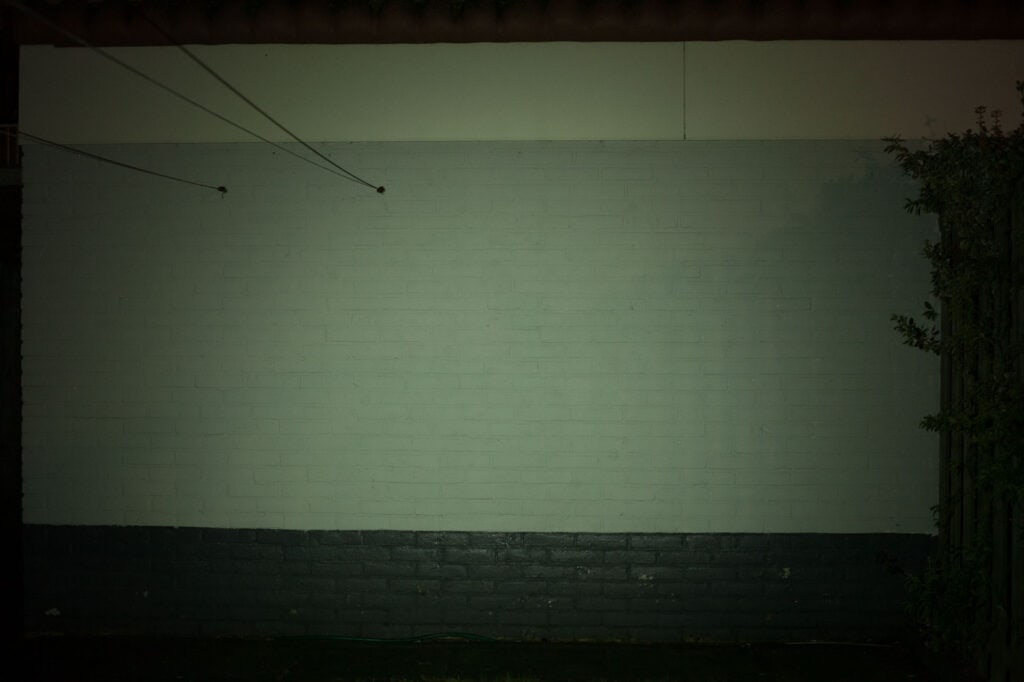
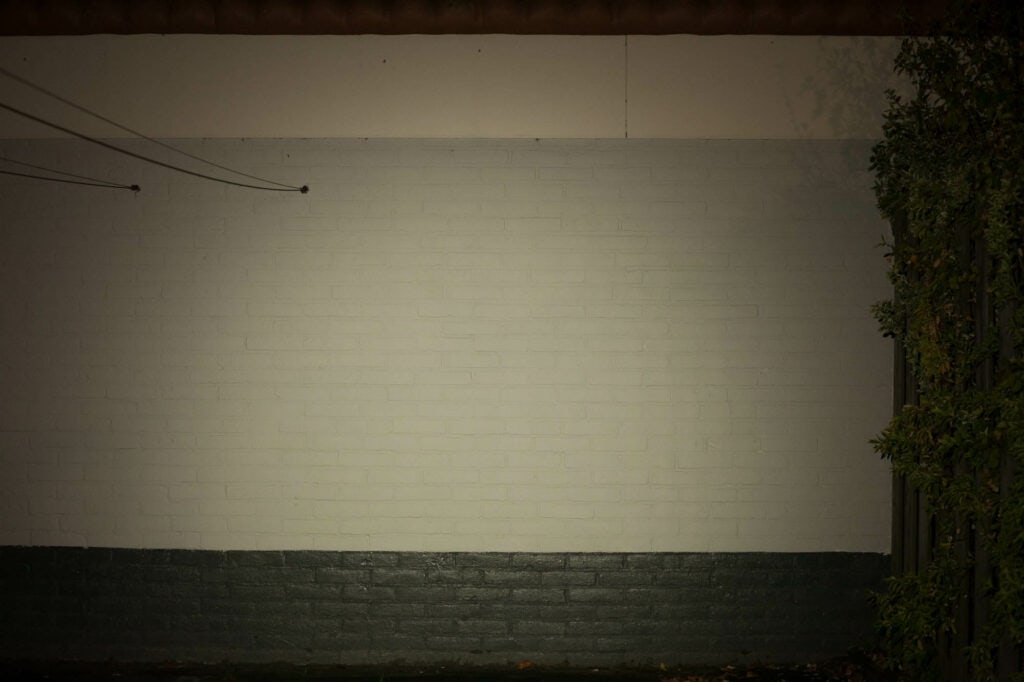
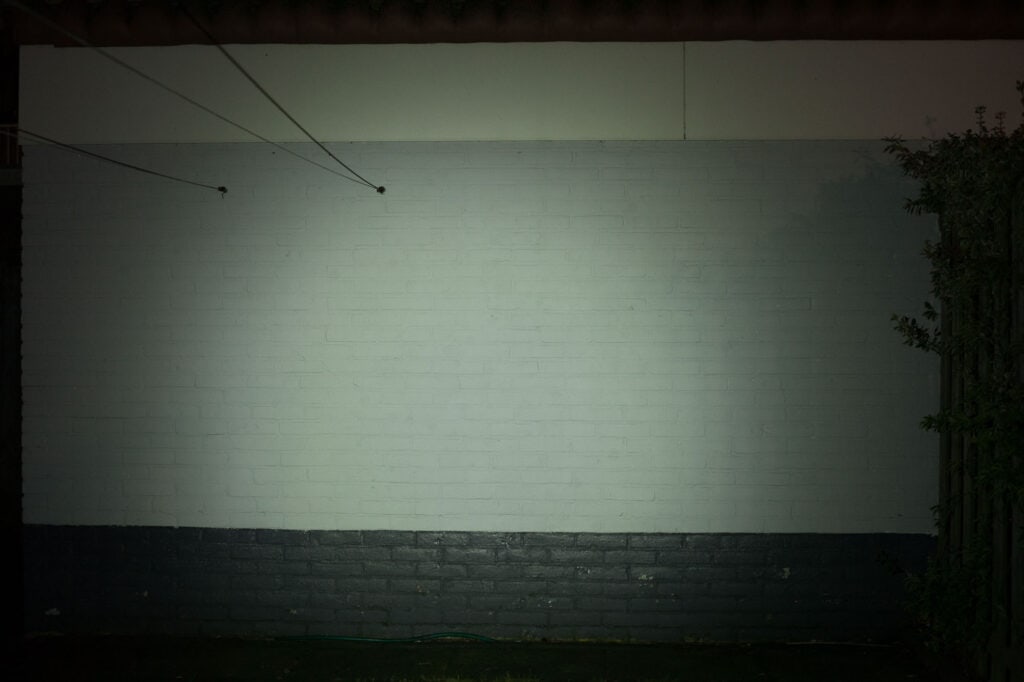


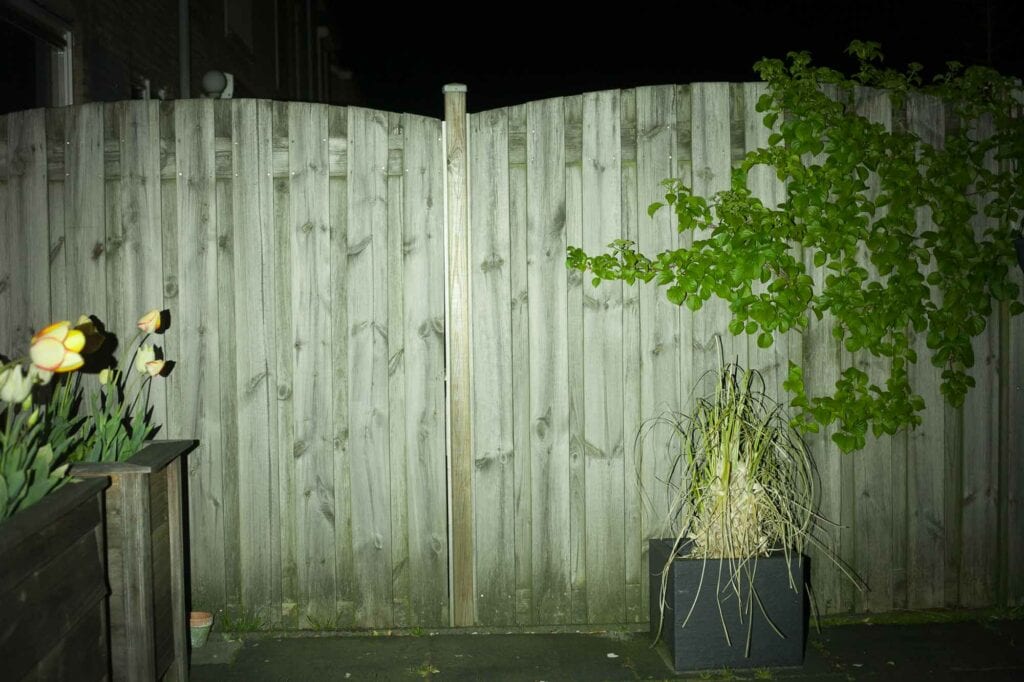
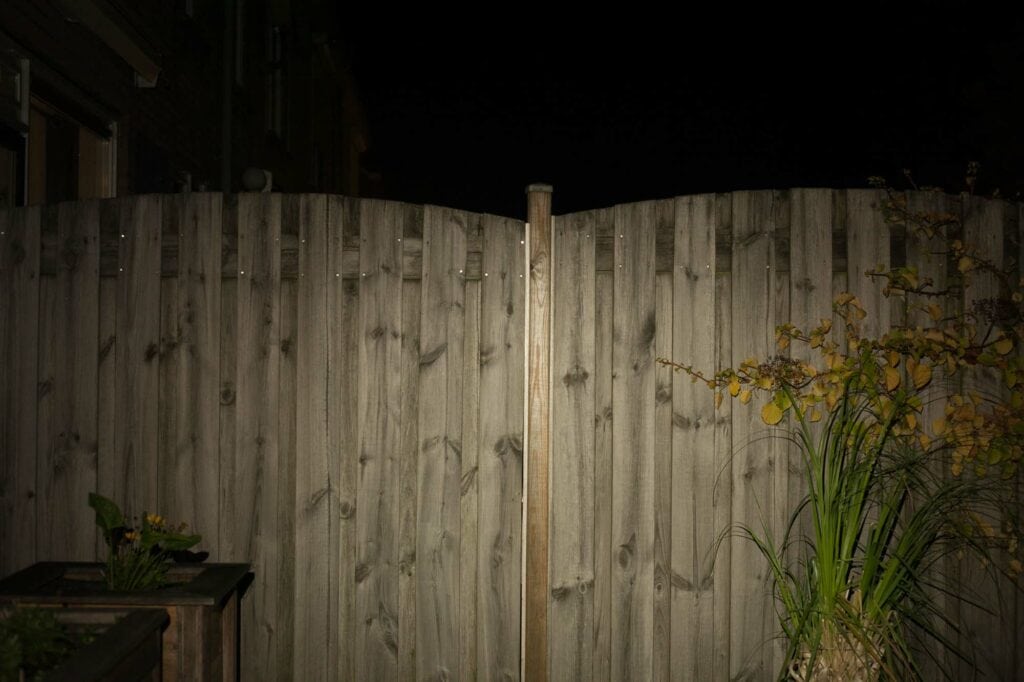









Disclaimer: This flashlight was sent to us for review at no cost by Streamlight Netherlands. We have not been paid to review, nor have we been holding back on problems or defects.
Final Verdict
Pros
- Brighter than advertised
- Throws a bit farther than advertised
- Brighter than most other AA sized flashlights
- Available worldwide
- Charges faster than specified (2h 46min instead of 4h)
- Limited Lifetime warranty
- Includes rechargeable lithium battery and charging cable
Cons
- Switch in overhand position is not easy to click
- Low mode is not very low at 50lm
- Shorter runtimes than advertised
- Visible PWM in low mode
- Pricey for what you get
- Micro USB charging is a little dated
- Dry and thin/sharp threads on tailcap
- Strange working UI
Explanation on star ratings:
1: Avoid: my phone flashlight would be a better choice – 2: Poor: significant defect or issues; almost unusable – 3: Average: some defects or issues; but still usable 4: Good: recommended (minor issues) – 5: Great: highly recommended

3 stars: ★★★
While our star rating provides a reliable indicator, we encourage you to read the full review to make an informed decision based on your own needs and preferences.
I must say that the Streamlight Macrostream feels dated with Micro USB charging, but that wouldn’t bother me too much if it still performed well. What I really don’t like is the clearly visible PWM in low mode, and strange UI. You can’t comfortably move back from Low to High, without waiting at least a full second (possibly 2).
If Streamlight got rid of PWM in low mode, moved to USB-C for charging, upgraded the UI and switch, this could be a pretty okay light.
Runtimes were fine and it performed better than advertised in terms of maximum lumen output, and beam distance. So that’s a positive thing. And what I also like is the limited lifetime warranty, since not many companies have this.
Buy your Streamlight Macrostream USB here
1lumen selects and reviews products personally. We may earn affiliate commissions through our links, which help support our testing.